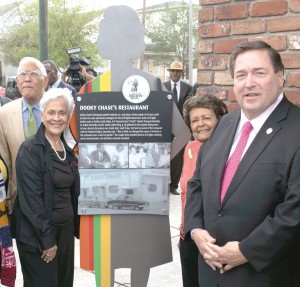La. paves trail to commemorate civil rights history
14th June 2021 · 0 Comments
By C.C. Campbell-Rock
Contributing Writer
On May 3, 2021, a small crowd outside of Dooky Chase’s Restaurant stepped into history as they witnessed the state’s first Civil Rights Trail marker unveiling. Renowned Chef Leah Chase’s larger-than-life steel silhouette held a placard that told the story of civil rights leaders and freedom riders’ strategic meetings in the restaurant’s “upper room.”
Sculptures commemorating the Baton Rouge Bus Boycott and Little Union Baptist Church were the second and third markers unveiled during National Travel and Tourism Week that honor people who risked their lives to make civil rights real in Louisiana.
The stories of the modern Civil Rights Movement in Louisiana remained largely hidden from public view until 2019, when Louisiana Lieutenant Governor Billy Nungesser tasked the Department of Culture, Recreation, and Tourism with creating a Civil Rights Trail in Louisiana.
Nungesser discovered Louisiana didn’t have a Civil Rights Trail while attending a conference. When civil rights came up and tourism officials from Alabama and Mississippi talked about the millions of visitors to their civil rights trails, the lieutenant governor said he was “embarrassed” to learn that Louisiana didn’t have one.

Edgar Chase III and Stella Reese Chase, are joined by Sybil Morial and La. Lt. Governor Billy Nungesser for the unveiling of the state’s first Civil Rights Trail marker that recognizes Dooky Chase’s Restaurant involvement in the Civil Rights Movement.
“After the presentation, right then and there, we committed to joining the U.S. Civil Rights Trail,” Nungesser said.
The project was two years in the making. Sharon Calcote, the CRT’s project manager, spearheaded the formation of the Louisiana Civil Rights Trail Site Review Committee, which reviewed 172 recommended sites. African-American history scholars from Southern, Xavier, Tulane, Dillard, UNO and the University of Louisiana at Lafayette and Monroe chose the first 15 commemorative sites.
Calcote held 22 meetings around the state to gather community input, in addition to doing extensive research in the state’s library system archives and the Library of Congress for the newspaper articles and films displayed on the Civil Rights Trail website.
“The passion, determination, and the stories that came out of the meetings” determined the design of the CRT, Calcote explained.
Calcote assembled a creative team including Norman Robinson, a former TV news anchor, who interviewed civil rights activists and eyewitnesses, and Glenda McKinley and her son Ernest McKinley English of GMC & Co. to design the iconic markers.
“We had the opportunity to create something for decades to come that pays respect to those in the movement,” said English, GMC & Co.’s associate creative director. “I said, let’s make it a human form.”
English and GMC & Co.’s art director, Benjamin Clay, collaborated on the markers. “We wanted to make something amazing to honor one of the most important movement’s in our country,” said English.
“We just wanted to do something different,” Clay asserted. They looked at other trail markers and had several designs from which to choose. “The client chose the human form because it is very relatable.”
Clay said working on the project was enlightening. “You never know the importance of what was going on in the background of the major stuff,” he added, drawing a parallel between Louisiana’s Civil Rights Movement and the national Civil Rights Movement. “They don’t teach you this in school. There’s a lot of stuff I didn’t know or was exposed to.”
Nungesser admits he never learned about the Civil Rights Movement in school. However, at each unveiling and meeting, the lieutenant governor learns about “the bravery and courage it took” for civil rights proponents to fight for their constitutional rights.
“There’s so much history here, some of it painful, but told in the right context, especially in the turbulent times we’re in today, wherever your politics, you’ve got to respect and honor those people that led the fight early on,” Nungesser, a white Republican added.
At each unveiling and meeting, the lieutenant governor learns, in real-time, about “the bravery and courage it took” for those in the movement to continue to pursue the civil rights promised to them. He also learned of the pain and suffering Black Louisianians endured.
During one meeting, a woman stood and said, “I’ve got a problem, Lt. Governor, with you using such a painful time in history to make money on tourism,” a comment that Nungesser expressed stuck with him.
“I couldn’t sleep that night,” Nungesser said.
The next day Nungesser asked his staff to “create an educational tool, with all the interviews, all the heroes, some of the stories are painful, but they need to be told.” The plan is to bring it to the Board of Elementary and Secondary Education and get teachers to download it.
“We always want to learn from the past and set a path forward that is better for all. The good news is, The Civil Rights Trail is educational, and it will bring tourism to areas that desperately need the economic shot in the arm,” Nungesser ensured.
The national debate over the teaching of Critical Race Theory and State Representative Cedric Glover’s legislation which adds African-American History as an optional requirement for TOPS scholarship recipients, make the Civil Rights Trail timely and necessary.
The state’s Department of Culture, Recreation, and Tourism will unveil more commemorative sculptures soon. According to Calcote, the project is organic, and does not have an end date. Nominations for sites are still being accepted on The Louisiana Civil Rights Trail website at www.louisiana-civilrightstrail.com.
This article originally published in the June 14, 2021 print edition of The Louisiana Weekly newspaper.



